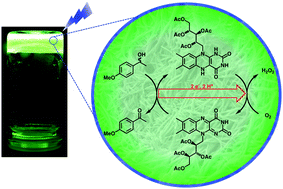Organophotocatalysis in nanostructured soft gel materials as tunable reaction vessels: comparison with homogeneous and micellar solutions†
Abstract
Riboflavin tetraacetate-catalyzed aerobic photooxidation of

* Corresponding authors
a
Institut für Organische Chemie, Universität Regensburg, Universitätsstr. 31, 93053 Regensburg, Germany
E-mail:
David.Diaz@chemie.uni-regensburg.de
Fax: +49 941 9434121
Tel: +49 941 943 4681
b
Instituto de Síntesis Química y Catálisis Homogénea (ISQCH), CSIC-Universidad de Zaragoza, Pedro Cerbuna 12, 50009 Zaragoza, Spain
E-mail:
diazdiaz@unizar.es
Tel: +34 976 76 3496
c CReST, Chemical Engineering Division, National Chemical Laboratory, Dr Homi Bhabha Road, 411008 Pune, India
d Department of Organic Chemistry, Indian Institute of Science, 560012 Bangalore, India
Riboflavin tetraacetate-catalyzed aerobic photooxidation of

 Please wait while we load your content...
Something went wrong. Try again?
Please wait while we load your content...
Something went wrong. Try again?
J. Bachl, A. Hohenleutner, B. B. Dhar, C. Cativiela, U. Maitra, B. König and D. D. Díaz, J. Mater. Chem. A, 2013, 1, 4577 DOI: 10.1039/C3TA01109G
To request permission to reproduce material from this article, please go to the Copyright Clearance Center request page.
If you are an author contributing to an RSC publication, you do not need to request permission provided correct acknowledgement is given.
If you are the author of this article, you do not need to request permission to reproduce figures and diagrams provided correct acknowledgement is given. If you want to reproduce the whole article in a third-party publication (excluding your thesis/dissertation for which permission is not required) please go to the Copyright Clearance Center request page.
Read more about how to correctly acknowledge RSC content.
 Fetching data from CrossRef.
Fetching data from CrossRef.
This may take some time to load.
Loading related content
